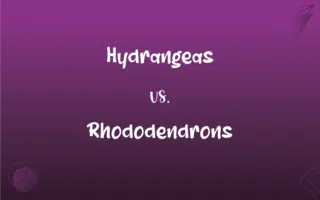NMOS vs. PMOS: What's the Difference?
Edited by Aimie Carlson || By Janet White || Published on July 19, 2024
NMOS (n-type metal-oxide-semiconductor) uses electrons as charge carriers, while PMOS (p-type metal-oxide-semiconductor) uses holes as charge carriers.

Key Differences
NMOS and PMOS are two types of metal-oxide-semiconductor field-effect transistors (MOSFETs) used in digital and analog circuits. NMOS transistors use n-type semiconductor material for the channel, where negatively charged electrons are the majority carriers. PMOS transistors, on the other hand, use p-type semiconductor material, where positively charged holes are the majority carriers. This fundamental difference in charge carriers leads to distinct electrical characteristics and applications for each type of transistor.
In terms of operation, NMOS transistors are typically faster than PMOS transistors due to the higher mobility of electrons compared to holes. This makes NMOS more suitable for high-speed applications. However, PMOS transistors have the advantage of lower power consumption, as they typically require less current to operate. This makes PMOS more suitable for low-power applications.
When it comes to circuit design, NMOS and PMOS transistors are often used together in complementary MOS (CMOS) technology. In CMOS, NMOS and PMOS transistors are paired to create logic gates that have low power consumption and high noise immunity. This combination takes advantage of the strengths of both types of transistors, making CMOS the dominant technology in modern digital circuits.
Another difference between NMOS and PMOS transistors is their response to input voltages. NMOS transistors conduct when the gate-to-source voltage is positive, while PMOS transistors conduct when the gate-to-source voltage is negative. This opposite behavior is leveraged in CMOS technology to create complementary logic gates that switch states efficiently, further reducing power consumption.
Understanding the differences between NMOS and PMOS transistors is crucial for designing efficient electronic circuits. While NMOS transistors offer speed advantages, PMOS transistors excel in power efficiency. By combining both types in CMOS technology, circuit designers can achieve a balance of performance and power consumption, making it the preferred choice for a wide range of applications.
ADVERTISEMENT
Comparison Chart
Charge Carriers
Electrons (n-type)
Holes (p-type)
Mobility
Higher mobility of electrons
Lower mobility of holes
Power Consumption
Generally higher
Generally lower
Speed
Faster due to higher electron mobility
Slower due to lower hole mobility
Response to Input Voltage
Conducts when gate-to-source voltage is positive
Conducts when gate-to-source voltage is negative
ADVERTISEMENT
NMOS and PMOS Definitions
NMOS
Characterized by n-type semiconductor material.
In NMOS technology, the channel is formed in p-type substrate.
PMOS
Conducts when the gate-to-source voltage is negative.
In PMOS, a negative voltage at the gate enables current flow.
NMOS
Generally has higher switching speed than PMOS.
NMOS transistors are preferred for high-speed applications.
PMOS
Typically consumes less power than NMOS.
The PMOS transistor is ideal for battery-operated devices.
NMOS
Conducts when the gate-to-source voltage is positive.
In NMOS, a positive voltage at the gate enables current flow.
PMOS
Characterized by p-type semiconductor material.
In PMOS technology, the channel is formed in n-type substrate.
NMOS
A type of MOSFET that uses electrons as charge carriers.
The NMOS transistor is widely used in digital circuits.
PMOS
A type of MOSFET that uses holes as charge carriers.
The PMOS transistor is often used in low-power circuits.
NMOS
Typically consumes more power than PMOS.
Despite its speed, NMOS is less power-efficient than PMOS.
PMOS
Generally has lower switching speed than NMOS.
PMOS transistors are slower but more power-efficient.
FAQs
What is NMOS?
NMOS stands for n-type metal-oxide-semiconductor, a type of MOSFET that uses electrons as charge carriers.
Which consumes less power, NMOS or PMOS?
PMOS typically consumes less power than NMOS, making it more suitable for low-power applications.
What is PMOS?
PMOS stands for p-type metal-oxide-semiconductor, a type of MOSFET that uses holes as charge carriers.
How do NMOS and PMOS transistors differ in charge carriers?
NMOS transistors use electrons, while PMOS transistors use holes as charge carriers.
What are some common applications of NMOS transistors?
Common applications of NMOS transistors include high-speed digital circuits, microprocessors, and memory chips.
Which is faster, NMOS or PMOS?
NMOS is generally faster than PMOS due to the higher mobility of electrons compared to holes.
Why are NMOS and PMOS often used together in circuits?
NMOS and PMOS are used together in CMOS technology to create logic gates with low power consumption and high noise immunity.
How does the mobility of charge carriers affect the performance of NMOS and PMOS transistors?
The mobility of charge carriers affects the switching speed and power consumption of NMOS and PMOS transistors, with higher mobility leading to faster speed and higher power consumption.
What is the main advantage of using NMOS transistors?
The main advantage of using NMOS transistors is their higher switching speed, making them suitable for high-speed applications.
What are the limitations of NMOS technology?
The limitations of NMOS technology include higher power consumption and susceptibility to hot-carrier degradation, which can affect the longevity and reliability of the transistors.
What are the limitations of PMOS technology?
The limitations of PMOS technology include lower switching speeds and reduced drive current capability compared to NMOS transistors.
How does the response to input voltage differ between NMOS and PMOS?
NMOS conducts when the gate-to-source voltage is positive, while PMOS conducts when the gate-to-source voltage is negative.
Can NMOS and PMOS transistors be used interchangeably in circuits?
NMOS and PMOS transistors cannot be used interchangeably due to their different electrical characteristics and responses to input voltages.
What is the significance of the substrate type in NMOS and PMOS technology?
The substrate type (n-type for PMOS and p-type for NMOS) is significant as it determines the type of semiconductor material and the polarity of charge carriers in the transistor.
What are some common applications of PMOS transistors?
Common applications of PMOS transistors include low-power devices, analog circuits, and power management systems.
What is the main advantage of using PMOS transistors?
The main advantage of using PMOS transistors is their lower power consumption, making them ideal for battery-operated devices.
What future advancements are expected in NMOS and PMOS technology?
Future advancements in NMOS and PMOS technology are expected to focus on further reducing power consumption, increasing switching speeds, and scaling down transistor sizes for more compact and powerful electronic devices.
How do NMOS and PMOS transistors contribute to the efficiency of CMOS technology?
NMOS and PMOS transistors contribute to the efficiency of CMOS technology by providing complementary switching behavior, which reduces power consumption and increases noise immunity in digital circuits.
How does temperature affect the performance of NMOS and PMOS transistors?
Temperature affects the performance of NMOS and PMOS transistors by influencing the mobility of charge carriers, with higher temperatures generally leading to decreased mobility and slower switching speeds.
How has the development of NMOS and PMOS technology impacted the semiconductor industry?
The development of NMOS and PMOS technology has significantly impacted the semiconductor industry by enabling the creation of more efficient, faster, and smaller electronic devices.
About Author
Written by
Janet WhiteJanet White has been an esteemed writer and blogger for Difference Wiki. Holding a Master's degree in Science and Medical Journalism from the prestigious Boston University, she has consistently demonstrated her expertise and passion for her field. When she's not immersed in her work, Janet relishes her time exercising, delving into a good book, and cherishing moments with friends and family.
Edited by
Aimie CarlsonAimie Carlson, holding a master's degree in English literature, is a fervent English language enthusiast. She lends her writing talents to Difference Wiki, a prominent website that specializes in comparisons, offering readers insightful analyses that both captivate and inform.








































































